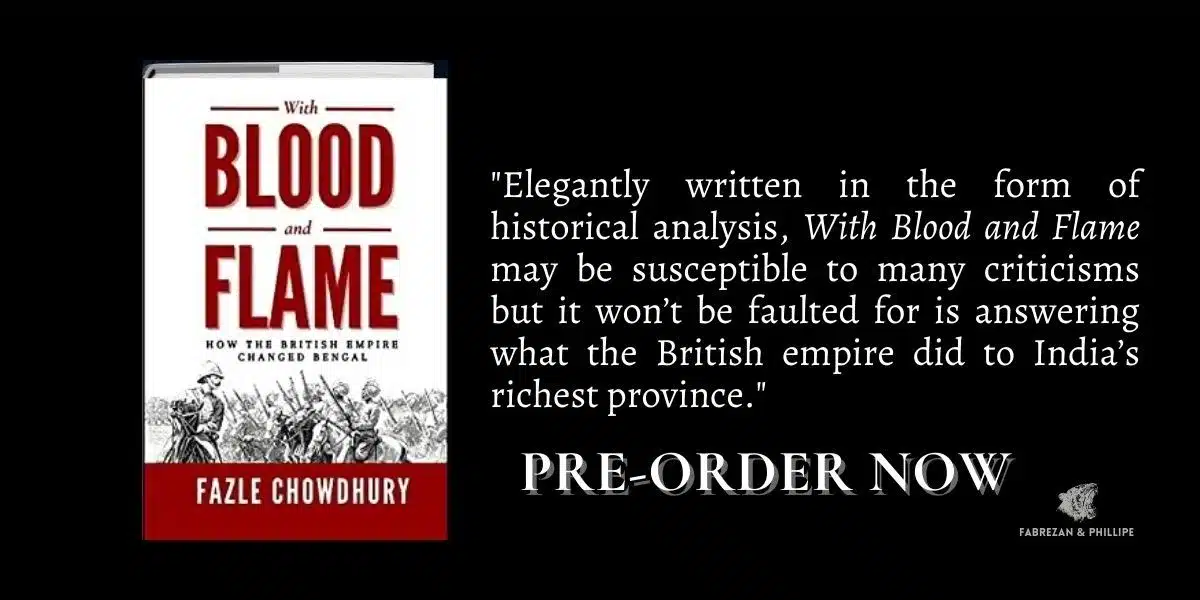Book Review: With Blood and Flame Explores Britain’s Colonial Impact on the then India’s Richest Province
Elegantly written in the form of historical analysis, With Blood and Flame may be susceptible to many criticisms, but it won’t be faulted for answering what the British empire did to India’s richest province.
Fazle Chowdhury, the author of seven books of fiction and non-fiction, is now providing that sharp rebuttal in his new book that the then richest province in the Indian subcontinent after nearly-200 years of British colonial rule went from ‘riches to rags’ both in culture and industry.
While Chowdhury is very good at tapping into the key details of several episodes of the past while keeping within the limits of his scope, new readers of the subject will be hungry for more. The book is full of historical detail, but very limited data to back the author’s claims. Naturally, this only tells one version of the story and leaves a pool of doubters waiting to pounce on the validity of the author’s assertions. For example, Chowdhury frequently is specific to the downside of British colonialism and rarely speaks to the benefits of the empire. However, even on the positive fronts, he finds ways to show how the British presence destroyed the fabric of Hindu Bengal by citing only a handful of examples that only suit his scope. In the end, pro-West readers will find gaps in coming around to Chowdhury’s case of British responsibility for the degradation of a wealthy province. In addition, while Chowdhury is remarkably on the mark between events happening in Europe and how that translated to colonial rivalries in India, he frequently writes in favor of other colonial powers like that of the French and Portuguese but consistently maintains a robust criticism of the British empire.
Many contemporary historians have written sympathetically about the role of Victorian politics and the actions of British colonial administrators in the Indian subcontinent. Chowdhury does not do that. He consistently targets the British colonial administrators for creating the foundation of several conflicts, future regional problems, and multiple occurrences, citing and blaming the British authorities for dividing several communities within the region. The author even goes further to cite British duplicity that is not only limited to Bengal or India, but the wider Middle East in Iraq, Palestine, and even after the empire had ended in places like Yemen.
Chowdhury rarely ventures into the problems of pre-British colonial rule, although he does highlight a few select examples of how the Islamization of Bengal and India did create complications that have lasted to this day.
In one of his examples, Chowdhury describes Kalapani, a cellular Jail in a colonial-era prison located in Port Blair, Andaman, and Nicobar Islands where the most treacherous of inhumane atrocities occurred and one which Chowdhury points the blame entirely on British colonial administrators. He does this because it was here where most Bengal and Indian nationalists were held as prisoners. Chowdhury speaks of the British treatment of nationalists as prisoners has parallels to the French prison of Château d’If and, shockingly, the Nazi concentration camp the Mauthausen. The parallels of a combination of an isolated French prison on a faraway island and the inhumane Nazi treatment of those held captive by British authorities also added with a hostile hot climate further pressed the horror and misery to those who served time in Kalapani.
With Blood and Flame, Chowdhury also speaks to the “Ungentlemanly British actions” where in the guise of “de-colonization” that began in 1947 (during and after Indian independence) in “Operation Legacy,” the British convenience to review secret documents in the colonial administrations and destroy those documents that could place the British government in a difficult situation then and in the future further added the credence of how awful the British empire actually was.
Finally, Chowdhury points out that those reiterating that the “British had civilized India” are simply incorrect. The British empire’s position as “extortionists” changed when they had few options but to grant India independence, not because it was bankrupt, which it was, but because the threat of the Indian revolutionaries was simply something the state could not stomach. Chowdhury says, “Britain left India as close of a Gentleman as a bankrupt colonial power could be,” but it also left behind a treacherous subcontinent with preventable divisions, with one war looming, followed by three more wars, a genocide and a series of famines rooted from its own time of rule. Something Britain should take responsibility for but never have.
For readers who want to understand the circumstances of British colonial rule in Bengal and India, then this is the book for you.



